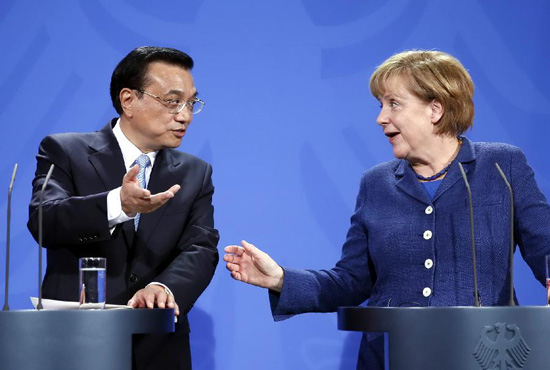李克強在德國《時代》周報發表署名文章(全文)
Full text: Li Keqiang's signed article on German newspaper
| 5月26日,李克強總理在柏林與德國總理默克爾舉行會談后共同會見記者。[新華網 鞠鵬 攝] Chinese Premier Li Keqiang (L) and German Chancellor Angela Merkel attend a joint press conference after their talks in Berlin, capital of Germany, May 26, 2013. [Photo/Xinhua] |
|
《百尺竿頭更進一步》
中德為什么能夠越走越近? 原因很簡單,就是雙方共同利益越來越大,相互需求越來越強。近年中德各領域合作發展迅速,兩國都把對方視作最重要的經濟伙伴之一,聯手應對國際金融危機使這種紐帶更加牢固。目前,中德合作已成為中歐合作的龍頭,雙方貿易額占到中歐貿易總額的30%左右。據中國商務部統計,去年德國對華實際投資達14.5億美元,增長了28.5%,中國對德投資項目數量位列第三,僅次于美國和瑞士。在全球經濟低迷的背景下,這一成績令人刮目相看。 兩國合作促進了彼此的發展。中國的長項是市場規模大,但在科技研發、企業管理、產品工藝等方面,從德國學習借鑒到很多。可以說,在中國現代化進程中,德國是持久的合作伙伴。雙方合作也為德國經濟增長增添了活力。中國汽車市場已占到大眾汽車全球銷量的30%,是寶馬公司全球第一大市場。西門子和巴斯夫公司也把中國作為全球第三大市場。 中德合作能繼續有所超越嗎? 答案是肯定的。目前中德合作已經達到歷史新高度,但中國有句老話,百尺竿頭更進一步。現在雙邊貿易額為1600多億美元,只占中國外貿總額3.8萬億美元的4%左右。在中國日益增長的對外投資中,德國所占的份額也比較低。中德相互促進、共同增長,是大有可為的。 同時,中國自身發展還有很大空間。我們將通過努力,到2020年使GDP和居民人均收入比2010年翻一番。中國有13億多人口,正在推進工業化、信息化、城鎮化、農業現代化,每年有1000多萬人口從農村轉移到城鎮,居民消費結構逐步升級,產業結構加快調整,這些都能持續釋放巨大的內需潛力。 尤其是中國的改革會帶來巨大紅利。過去30多年中國經濟持續快速發展,靠的是改革;今后促進經濟持續健康發展,還是要靠改革。目前中國改革已進入深水區、攻堅階段,我們將全面深化行政體制、財稅、金融、價格等重要領域改革,通過改革促進經濟轉型、民生改善、社會公正,激發市場的潛力和發展的動力。 開放也是改革,以開放促改革、促發展,是我們的重要經驗。中國奉行互利共贏的開放戰略,正在大力推進新一輪對外開放,使開放的領域更廣、開放的程度更深。我們將進一步擴大服務貿易領域開放,帶動服務業發展。今后五年,中國將進口10萬億美元左右的商品,對外投資規模累計將達到5000億美元。經濟的持續發展和改革開放的深化,會使中國市場規模不斷擴大,這有利于德國進一步開拓亞洲市場,為德國企業發展、為德國經濟繁榮提供更多機遇。 |
Open Up New Horizon for China-Germany Relations I will soon be visiting Germany again to boost China's cooperation with Germany on all fronts. People may want to learn more about the visit, and I believe that one can find answers in both the historical evolution of and current necessity for China-Germany cooperation as well as in China's ongoing reform and opening up. Why are China and Germany getting closer? The reason is simple: Both our common interests and mutual need are growing. In recent years, we have enjoyed rapid growth in bilateral cooperation across the board, and we regard each other as one of our most important business partners. This bond has been enhanced by our joint response to the international financial crisis. Today, cooperation between our two countries has become the engine driving China-EU cooperation, with China-Germany trade taking up roughly 30 percent of China's total trade with Europe. According to statistics of China's Ministry of Commerce, German paid-in investment last year in China increased by 28.5 percent to reach 1.45 billion U.S. dollars, and China became the third largest foreign investor in Germany in terms of project number, next only to the United States and Switzerland. This is remarkable in a sluggish global economy. China-Germany cooperation has contributed to our respective growth. China has a large market, which is our strength. But we have learnt a lot from Germany in terms of research and development, corporate governance and technologies. Germany is China's long-term partner in its pursuit of modernization. Cooperation with China has also stimulated Germany's growth. The Chinese market accounts for 30 percent of Volkswagen's global sales and is the largest market for BMW. China is also the third largest market for Siemens and BASF. Can we aim for even closer cooperation?
What's more, China itself has vast space for development. We will work hard to double the size of the 2010 GDP and per capita income by 2020. China, a country with over 1.3 billion people, is simultaneously pursuing industrialization, application of information technologies, urbanization and agricultural modernization. Every year, over 10 million rural people move to cities. The mix of individual consumption is being upgraded, and economic structural adjustment is accelerating. All these will release huge potential in domestic demand. In particular, reform in China will yield huge dividend. China has relied on reform to achieve sustained and fast growth in the past three decades or so, and it will continue to rely on reform for sustained and sound growth going forward. Reform in China has now entered a deep-water zone where tough challenges need to be tackled. We will fully deepen reform in key areas such as administrative system, fiscal policy and taxation, finance and pricing in order to shift the growth model, improve people's lives, promote social equity and unleash market potential and the driving force for development. Opening up is also a kind of reform. To advance reform and development through opening up is an important experience we have gained. China follows a win-win strategy of opening up. We are vigorously promoting a new round of opening up to increase openness in both breadth and depth. We will make our trade in services still more open to drive the growth of the service sector. In the coming five years, China will import about ten trillion dollars of goods and invest 500 billion dollars overseas. Sustained economic growth and further reform and opening up will bring about an ever growing market in China. This will give Germany greater access to the Asian market and provide more opportunities for growth of German businesses and economic prosperity of Germany. |
 0
0 







